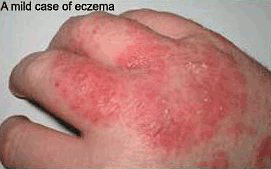Contact Eczema Treatment
Eczema-Ltd III has been providing treatment for contact eczema for over 10 years. Eczema-Ltd III is one of the easiest products to use to treat contact eczema. Unlike other products on the market, there is no messy/smelly cream to deal with. The unique shape of Eczema-Ltd III, allows the users to use it anywhere on the body. Also we offer a 120 day 100% refund.
Treating the contact eczema, is rather simple. Wash the affected area with a mild soap and water, where you have had contact with an allergen. While the affected area is still wet, glide the Eczema-Ltd III disk over the area for a few seconds. Our product will dry in about 10 seconds. Once it is dry use jojoba oil for a moisturizer.
We highly recommend the following brands of soaps. These soaps can be purchased at any major super market, pharmacy and even online.
Some other ways to avoid, contact eczema:
- Ceasing contact with the offending substance would be the ideal, but this is often impractical. In these circumstances, however, the aims of treatment can only be to reduce symptoms. Unfortunately, some irritants cause skin reaction even with very little exposure.
- Using protective gloves - Since latex or rubber in gloves can cause or worsen eczema, some people find it helpful to use cotton-lined gloves or separate cotton inner gloves to reduce the degree of direct skin contact.
Still unsure of Eczema-Ltd III, then read our Compare your past Eczema Treatment with Eczema-Ltd III.
Causes of Contact Eczema
The symptoms of almost all the types of eczema cause itching and redness, and some will blister, weep or peel. The degree of severity varies with each individual from a mild form of dry, easily irritated sensitive skin, to a severe form in which the skin is broken, scaly, raw, bleeding and can be prone to recurring infections. Contact eczema is caused by physical contact with an irritant or allergen.
Contact eczema can be divided into two distinct problems:
- Direct Irritant Contact Dermatitis: Results from exposure to acids, alkaline mixtures, detergents and various other chemicals that acutely inflame the skin. The condition can become chronic with repeated exposure. This form of eczema is often encountered in the workplace. Direct irritant contact eczema can occur at the first exposure to the irritant. For example, most people will develop eczema on first exposure to strong chemicals that are acid or alkaline in nature.
- Allergic Contact Dermatitis: Results from exposure to an allergen that sensitizes the skin leading to acute inflammation when re-exposure occurs. Prior exposure to the agent is necessary for allergic contact eczema to occur.

It is easier to find the cause of Irritant Contact Eczema than it is to find the cause of Allergic Contact Eczema. Because there is generally a time lapse between contact of an allergy-causing chemical and the outbreak of the allergic rash, it can be difficult to identify the allergen causing the rash.
There can also be difficulties distinguishing allergic contact eczema (which is an immune response) from irritant eczema (which is a direct skin reaction against an irritant substance). In practice, this difference is not so important because the same lines of treatment are required for both.
In particular, a search needs to be made to try and identify a possible allergen. The most common way to do this is to test a person's skin against a battery of standard test substances, all of which are known to possibly cause contact allergy. This is called 'patch testing'.
If allergy testing reveals a cause that can be removed, the problem is quite likely to resolve. This is not true for everyone, particularly individuals with hand eczema. It is unclear why this is so. Sensitivity will remain dormant, however, and later exposure will be followed by an eczema reaction.
Moisturizers do work for contact eczema, but the extent of improvement also depends on the degree of sensitization and the level and frequency of exposure to the allergen.
If the offending substance is repeatedly being re-applied to the skin, this can result in using a lot of treatment to little effect.

